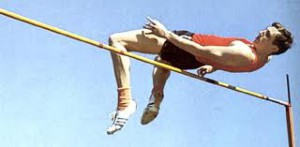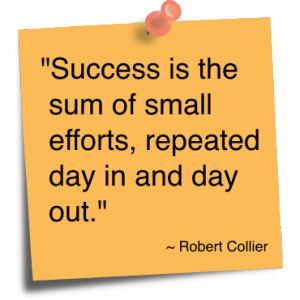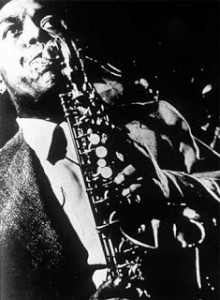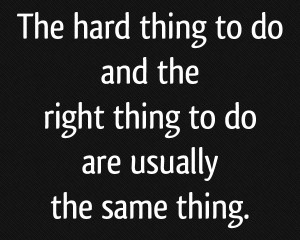Learning not to be a jerk
Following is a fun excerpt from OutThink…enjoy!

One evening after berating myself again for being an ogre of a parent, I decided that the next morning I just wasn’t going to behave that way again. I resolved that regardless of whether they missed the bus or not, I simply was not going to be a jerk to my kids. While a nice idea, it did require I try something else.
I decided I would simply advise them of the time and ask them what the next steps were. So instead of, “Get your lunch in your bag!” I might say, “Looks like we have about 14 minutes. Is your bag ready?” Or if Annie asked me to play Taylor Swift songs on the kitchen iPod stereo, I might say “Well, we have about 20 minutes, do you think we have time?” Sometimes she decided we did have time to listen to Taylor Swift, sometimes not.
It really worked. We had a few close calls, the first few days, but it worked. I would simply point out the time, and almost immediately they learned to watch the clock and developed an awareness of when the bus would arrive (our bus is quite punctual). My whole demeanor changed from dictatorial bus baron to simply asking what was left on their check list in the next X minutes. I would ask if they brushed their teeth or packed their homework, but in an inquisitive way, not as a command. I’m also convinced this morning behavior shift worked because I truly didn’t care if they missed the bus. I was completely prepared to drive them, but I never admitted it out loud. I kept up the shared expectation that we always ride the bus, I just shifted the accountability from me to them. Making the bus became their responsibility; I was just there to help the process.
Believe me, we don’t claim to be model parents, and I find it almost impossible to manage the logistics of our lives these days (last night I missed a soccer meeting by an hour…), but now in the morning we have four kids successfully making two different bus times and very rarely miss it. They watch the clock, punch the list, and make the bus.
According to a study at Duke University, almost 45 percent of our daily activity is habitual. It wasn’t easy to stop barking orders at my kids. It had become an ingrained habit.
In equal parts we have to selectively abandon past behavior, carry on with what works, and pick up new habits and actions.


 In 1968 Dick Fosbury astonished the world at the Mexico City Olympic Games by clearing 7′ 4″ 1/4 inches in the high jump. His efforts before 80,000 people were an aberration – an anomaly in track and field events. Dick was a gangly 6’3″ athlete who hadn’t excelled at any event in track and field at his Medford, OR high school and he unveiled a maneuver to set a world record. More remarkably, his competitors failed to recognize and adopt his innovative style and lost – not only on that occasion, but for years to come because they couldn’t acknowledge the power of his innovation.
In 1968 Dick Fosbury astonished the world at the Mexico City Olympic Games by clearing 7′ 4″ 1/4 inches in the high jump. His efforts before 80,000 people were an aberration – an anomaly in track and field events. Dick was a gangly 6’3″ athlete who hadn’t excelled at any event in track and field at his Medford, OR high school and he unveiled a maneuver to set a world record. More remarkably, his competitors failed to recognize and adopt his innovative style and lost – not only on that occasion, but for years to come because they couldn’t acknowledge the power of his innovation.
 In the wake of hurricane Katrina, numerous people throughout the gulf coast area had lost homes, and were in need of basic food, shelter and care. With sporadic electricity available in the region, cash became critical to sustaining people’s lives.
In the wake of hurricane Katrina, numerous people throughout the gulf coast area had lost homes, and were in need of basic food, shelter and care. With sporadic electricity available in the region, cash became critical to sustaining people’s lives.
 Woodshedding is an old jazz expression – it means to go deep in isolation to build your chops, get your groove on, master your instrument. As the legend goes, in 1937, when he was only 17 years old, young Charlie Parker – before he became the great “Bird” Parker – would go down to the High Hat Club, also known as “the cutting room” to play with the great session musicians of the day.
Woodshedding is an old jazz expression – it means to go deep in isolation to build your chops, get your groove on, master your instrument. As the legend goes, in 1937, when he was only 17 years old, young Charlie Parker – before he became the great “Bird” Parker – would go down to the High Hat Club, also known as “the cutting room” to play with the great session musicians of the day. It never really occured to me. It didn’t occur to my wife. Candy never thought of it either. The morning when Annie and I got in the car, it did cross my mind, but only briefly enough to send a quick text to Candy asking, “Do you think it’s OK if I bring Annie?” It never seemed such a concern that I should call in advance or question it. Although alas, that decision changed the day.
It never really occured to me. It didn’t occur to my wife. Candy never thought of it either. The morning when Annie and I got in the car, it did cross my mind, but only briefly enough to send a quick text to Candy asking, “Do you think it’s OK if I bring Annie?” It never seemed such a concern that I should call in advance or question it. Although alas, that decision changed the day.